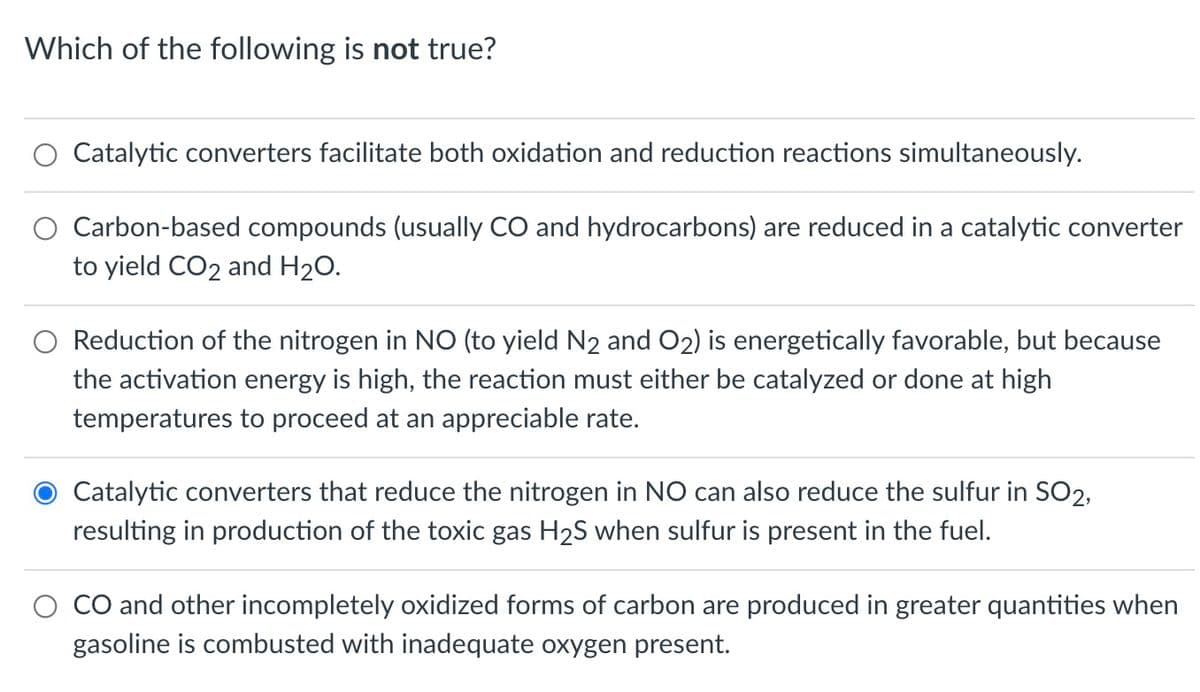Which of the following is not true? O Catalytic converters facilitate both oxidation and reduction reactions simultaneously. O Carbon-based compounds (usually CO and hydrocarbons) are reduced in a catalytic converter to yield CO2 and H20. Reduction of the nitrogen in NO (to yield N2 and O2) is energetically favorable, but because the activation energy is high, the reaction must either be catalyzed or done at high temperatures to proceed at an appreciable rate. Catalytic converters that reduce the nitrogen in NO can also reduce the sulfur in SO2, resulting in production of the toxic gas H2S when sulfur is present in the fuel. CO and other incompletely oxidized forms of carbon are produced in greater quantities when gasoline is combusted with inadequate oxygen present.
Which of the following is not true? O Catalytic converters facilitate both oxidation and reduction reactions simultaneously. O Carbon-based compounds (usually CO and hydrocarbons) are reduced in a catalytic converter to yield CO2 and H20. Reduction of the nitrogen in NO (to yield N2 and O2) is energetically favorable, but because the activation energy is high, the reaction must either be catalyzed or done at high temperatures to proceed at an appreciable rate. Catalytic converters that reduce the nitrogen in NO can also reduce the sulfur in SO2, resulting in production of the toxic gas H2S when sulfur is present in the fuel. CO and other incompletely oxidized forms of carbon are produced in greater quantities when gasoline is combusted with inadequate oxygen present.
Chemistry by OpenStax (2015-05-04)
1st Edition
ISBN:9781938168390
Author:Klaus Theopold, Richard H Langley, Paul Flowers, William R. Robinson, Mark Blaser
Publisher:Klaus Theopold, Richard H Langley, Paul Flowers, William R. Robinson, Mark Blaser
Chapter12: Kinetics
Section: Chapter Questions
Problem 11E: In the PhET Reactions under Options. (a) Leave the Initial Temperature at the default setting....
Related questions
Question

Transcribed Image Text:Which of the following is not true?
Catalytic converters facilitate both oxidation and reduction reactions simultaneously.
Carbon-based compounds (usually CO and hydrocarbons) are reduced in a catalytic converter
to yield CO2 and H20.
O Reduction of the nitrogen in NO (to yield N2 and O2) is energetically favorable, but because
the activation energy is high, the reaction must either be catalyzed or done at high
temperatures to proceed at an appreciable rate.
Catalytic converters that reduce the nitrogen in NO can also reduce the sulfur in SO2,
resulting in production of the toxic gas H2S when sulfur is present in the fuel.
CO and other incompletely oxidized forms of carbon are produced in greater quantities when
gasoline is combusted with inadequate oxygen present.
Expert Solution
This question has been solved!
Explore an expertly crafted, step-by-step solution for a thorough understanding of key concepts.
This is a popular solution!
Trending now
This is a popular solution!
Step by step
Solved in 2 steps

Knowledge Booster
Learn more about
Need a deep-dive on the concept behind this application? Look no further. Learn more about this topic, chemistry and related others by exploring similar questions and additional content below.Recommended textbooks for you

Chemistry by OpenStax (2015-05-04)
Chemistry
ISBN:
9781938168390
Author:
Klaus Theopold, Richard H Langley, Paul Flowers, William R. Robinson, Mark Blaser
Publisher:
OpenStax

Chemistry: The Molecular Science
Chemistry
ISBN:
9781285199047
Author:
John W. Moore, Conrad L. Stanitski
Publisher:
Cengage Learning

Chemistry by OpenStax (2015-05-04)
Chemistry
ISBN:
9781938168390
Author:
Klaus Theopold, Richard H Langley, Paul Flowers, William R. Robinson, Mark Blaser
Publisher:
OpenStax

Chemistry: The Molecular Science
Chemistry
ISBN:
9781285199047
Author:
John W. Moore, Conrad L. Stanitski
Publisher:
Cengage Learning